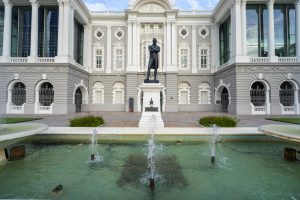Writing Singapore’s History: Pragmatism and Barring Pre-Colonial Narratives
August 8, 2022

On 9 August 1965, Singapore separated from Malaysia and gained its independence. To commemorate the country’s sovereignty, National Day is celebrated annually on 9 August with a National Day Parade and the prime minister’s address. The events are broadcasted across local channels, in the country’s four national languages, for the public’s free viewing. While Singapore’s history of independence is one that the country proudly memorialises, celebrating its colonial past is often debated.
2019 marked the bicentennial of Thomas Stamford Raffles’ arrival in Singapore. Professor Tan Tai Yong (NUS Department of History), the sixth awardee for the Institute of Policy Studies’ (IPS) S R Nathan Fellow for the Study of Singapore, reflects upon this anniversary in “The Long and Short of Singapore History: Cycles, Pivots and Continuities Tie to National Day” (The Idea of Singapore, 2019), the first of his six IPS-Nathan Lectures. Keeping in mind the concerns surrounding the celebration of an imperialist figure’s arrival and rule of the country, Professor Tan shares various approaches one can consider when studying the country’s history.
Looking back at the challenges and priorities of Singapore’s post-independence government, Professor Tan reminds us that contemplating the past was the least of the People’s Action Party’s (PAP) worries. The PAP had to put in place a working economy while upkeeping social harmony for the survival of the newly independent country. Later, the PAP, despite having anti-colonial roots, decided to include Stanford Raffles’ arrival and Singapore’s colonial past in the National Education (NE) of Singapore’s history. This history of Singapore was written to teach an objective history through NE and as a pragmatic decision to attract foreign investors through the acceptance of a colonial past.
Professor Tan also briefly outlines Singapore’s pre-colonial history, dating back to the late thirteenth century, as derived from “Chinese historical texts and Malay oral tradition”. As part of the Melaka sultanate, the island was exposed to the influence and commerce of three trade networks, the South China Sea, South Asia, and West Asia. By the seventeenth century, Singapore found itself situated in the cross-waters of maritime conflict between the Portuguese, Dutch, and English, which led to the rising prominence of waters surrounding Singapore. This eventually led to the East India Company’s Straits Settlement in 1819, which marked the start of Singapore’s colonial past. Concluding his lecture, Professor Tan explains how observing the different cycles, pivot points, and continuities of Singapore’s past can help in establishing a clearer framework of the country’s history.
Read the full lecture and question-and-answer session transcript here.
